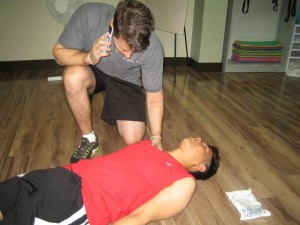The severity of falls vary greatly as some mild falls may only cause a few bruises or scratches, the more severe ones may lead to concussions, convulsions and broken bones.
When you witness a person fall, make sure there are not any serious injuries such as heavy bleeding, broken bones or signs of seizures. You must also make sure that the casualty is conscious. If you suspect that the fall was a severe one, do not move the person until you are sure there aren’t any head, back, hip or neck injuries.
When to seek medical help

- If the victim is unconscious, even for a brief period of time–concussion
- If the victim becomes sleepy or it is difficult to wake him—concussion
- If the victim is not waking up like he normally does—concussion
- Dizziness—concussion
- Breathing difficulties
- Clear fluid discharge from the ears, nose or mouth
- Vomiting
- Says that he is feeling severe pain
- Impaired or blurred vision
- Large/deep wounds
- Behavioral changes such as loss of appetite
- Children may cry continuously
- Adults may seem irritable and moody
First aid
Cover the checklist on the emergency action plan and make sure help is on its way if any of the severe symptoms occur. You must make sure that the mild injuries are taken care of—rinsed with soap and water and covered with antibiotic ointment and sterile gauze. If the casualty is unconscious, check for signs of breathing and begin CPR till help arrives. Note that you must never move a casualty who has undergone a head, back, neck or hip injury—unless you have to take him somewhere safer, such as from a bust road.
Older adults tend to be victims of severe falls, therefore, make sure they are taken to the emergency room promptly if they exhibit serious symptoms. Additionally, young children also should be treated with care, even if the situation does not look like an emergency—monitor your child for 24 hours and see if any of the above mentioned symptoms kick in. if you suspect a concussion due to a head injury, it is best to seek medical attention quickly.
For more information about managing victims of varying types of fall’s enrol in first aid and CPR training near you.
Prevention
It is not easy to prevent falls with older adults and young children, but you can reduce the risks by following a few safety precautions. In case of young children and infants, it is always best to secure them with a seat belt in cars and make sure they are properly secured from falling from high chairs, strollers, and changing tables. Teach your children to be careful and familiarize them with the harmful effects of jumping off of tables and chairs. Additionally, you can also make sure your child wears safety equipment such as helmets, elbow and knee pads while engaging in any sports activities.
Related Video to Falls
